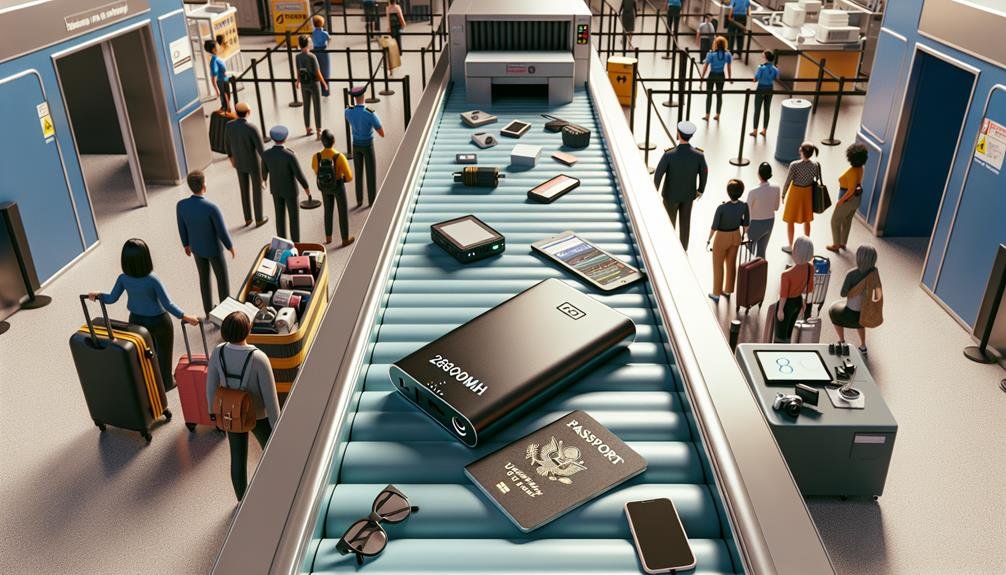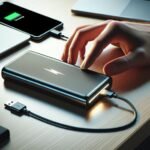You can bring a 26800mAh power bank on your flight since it falls below the 100Wh threshold set by most airlines and regulatory bodies like IATA and FAA. Make sure to carry it in your carry-on luggage, as power banks are prohibited in checked bags. Airlines require these devices to be individually protected to prevent short circuits. Usually, passengers are allowed to carry multiple power banks, but you must check cumulative Wh limits. For detailed guidelines and practical travel tips, there's more to uncover about safe air travel with electronic devices.
Airline Policies
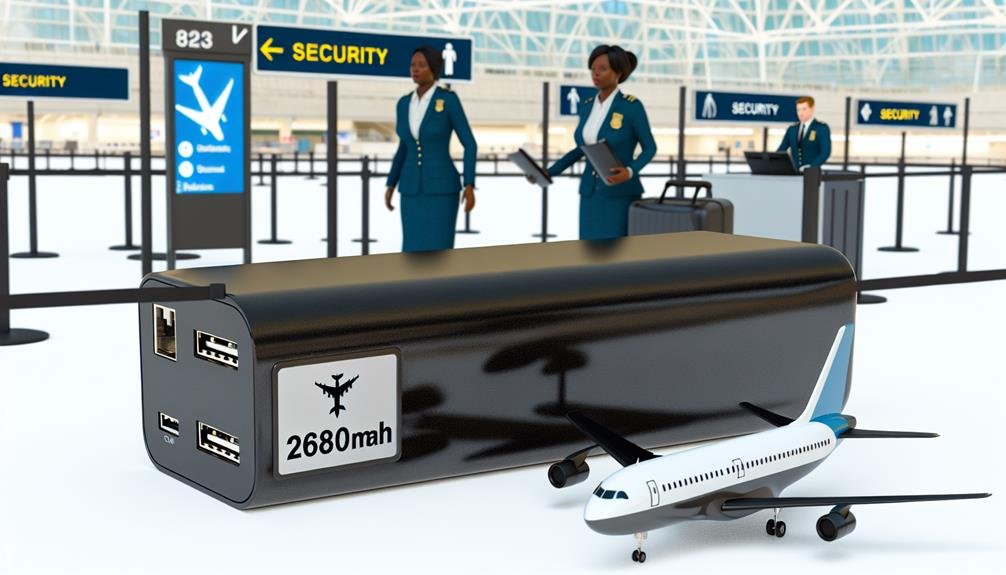
Airline policies regarding the transport of power banks, particularly those with capacities like a 26800mAh battery, are governed by strict regulatory guidelines to guarantee passenger safety. Airlines categorize power banks as charging devices and portable power sources, necessitating specific handling procedures. You'll find that most airlines stipulate power banks must be carried in carry-on luggage rather than checked baggage. This is due to the potential risks associated with lithium-ion batteries, such as overheating or short-circuiting.
For a 26800mAh power bank, equivalent to approximately 99.16Wh (Watt-hours), airlines generally permit its transport as it falls under the 100Wh limit set by the International Air Transport Association (IATA). You should, however, verify the specific airline's policy, as some carriers may have more stringent regulations. Typically, passengers are allowed to carry multiple power banks, but the cumulative Wh should not exceed a specified limit, often around 300Wh.
Airlines may also require that power banks are individually protected to prevent short circuits. You'll need to make sure your charging devices are packed securely, with terminals covered or insulated. Always consult your airline's guidelines before traveling to avoid any last-minute issues at security checkpoints.
Safety Regulations
Securing the safe transport of power banks, especially those with high capacities like 26800mAh, involves following strict regulations designed to mitigate risks associated with lithium-ion batteries. Regulatory bodies such as the International Air Transport Association (IATA) and Federal Aviation Administration (FAA) have established specific lithium battery regulations to guarantee passenger safety.
Power bank restrictions are implemented to prevent potential hazards like overheating, fire, or explosion. You must carry power banks in your carry-on luggage, as placing them in checked baggage poses a higher risk. Airlines typically require power banks to be individually protected to prevent short circuits—this can be achieved using plastic bags or protective covers.
Furthermore, there's a limit to the number of lithium batteries you can carry, generally capped at two spare batteries per passenger. Compliance with these safety measures is not just a suggestion but a necessity.
When considering travel essentials, it's important to verify your power bank's specifications and confirm they adhere to the airline's guidelines. By following these lithium battery regulations and power bank restrictions, you contribute to a safer travel environment for everyone on board.
Battery Capacity Limits
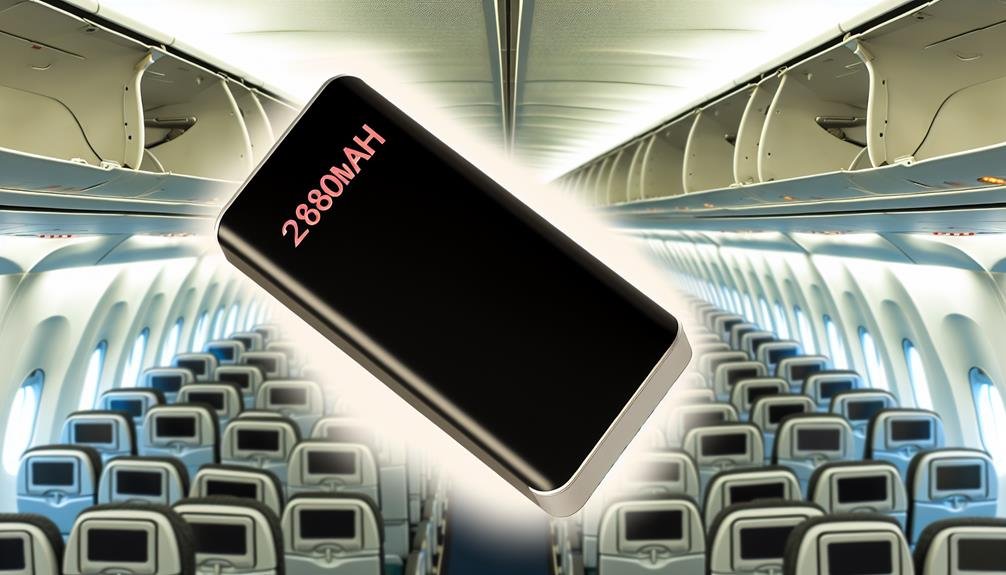
When traveling by air, it's important to mention that power banks with a capacity exceeding 100 watt-hours (Wh) often require airline approval before boarding. Most airlines follow the International Air Transport Association (IATA) guidelines, which set battery restrictions to guarantee passenger safety. Typically, power banks under 100Wh are allowed without special permissions. However, devices between 100Wh and 160Wh may be permitted with airline approval, while those exceeding 160Wh are generally prohibited.
For a 26800mAh power bank, the capacity in watt-hours can be calculated (mAh/1000) * Voltage (V). Assuming a nominal voltage of 3.7V, this power bank has a capacity of approximately 99.16Wh. Therefore, it falls under the 100Wh threshold and should be allowed without prior approval, though it's always wise to verify with your airline due to potential variations in regulations.
Security checks will scrutinize your power bank during screening. Ensure it's easily accessible and complies with capacity limits. Additionally, familiarize yourself with charging options on the flight. Some airlines offer USB ports or power outlets, which can reduce your reliance on the power bank, further enhancing onboard safety.
Carry-On Vs. Checked Bags
Due to strict safety regulations, power banks are generally required to be carried in your carry-on baggage rather than checked bags. This is mainly because power banks, classified as lithium-ion batteries, pose a risk of combustion and must be easily accessible in case of a thermal event. Carrying them in your carry-on allows for immediate intervention by the flight crew, ensuring passenger well-being.
Security checks at airports are designed to detect prohibited items and guarantee compliance with aviation safety standards. As part of these security protocols, electronic devices, including your 26800mAh power bank, must be presented separately during screening. This aids in a thorough inspection and verification that the device meets airline luggage restrictions.
Furthermore, carrying your power bank in the cabin provides you with convenient charging options for your electronic devices throughout the flight. Checked baggage is stored in the aircraft's hold, where temperature and pressure can fluctuate, potentially exacerbating risks associated with lithium-ion batteries. Thus, following these regulations is essential for maintaining safety on board.
Practical Travel Tips
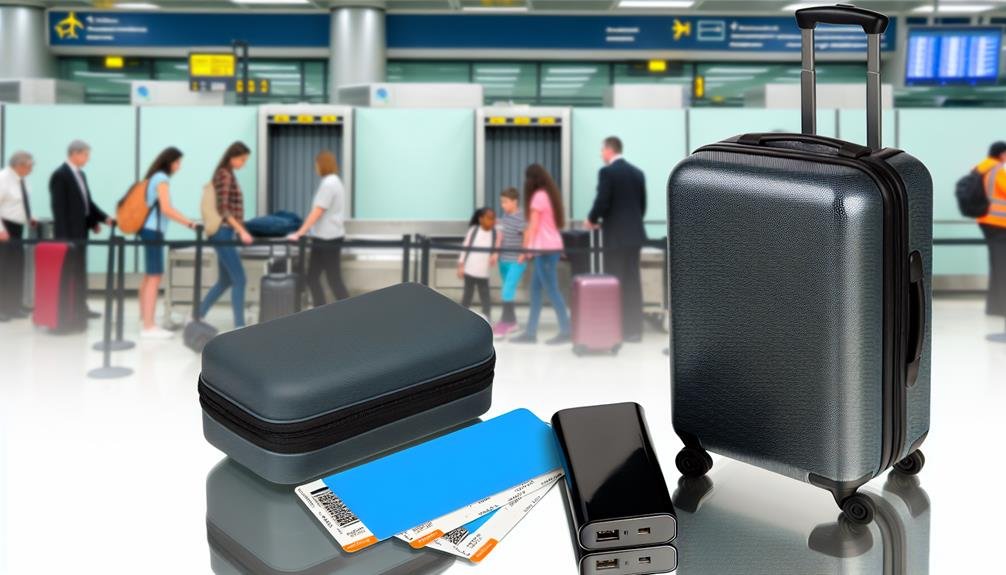
Given the stringent regulations surrounding the carriage of power banks in your carry-on, it's advisable to ponder several practical travel tips to guarantee compliance and convenience. To begin with, ensure that your 26800mAh power bank is easily accessible. You'll need to present it separately during security screening, as per TSA guidelines. Prioritize packing essentials—place your power bank and other travel gadgets in a dedicated compartment within your carry-on for swift retrieval.
Regulatory compliance is paramount. Check the watt-hour (Wh) rating of your power bank. For a 26800mAh unit, it should be approximately 99.16Wh (26.8Ah x 3.7V). This is under the 100Wh limit, making it permissible on most flights. However, always verify specific airline policies as they may vary.
For safety, use a power bank that adheres to international safety standards, such as UL 2056. Avoid overpacking your carry-on to reduce the risk of damaging your travel gadgets. Securely wrap charging cables to prevent short circuits.
Frequently Asked Questions
How Do I Check My Power Bank's Watt-Hour Rating?
To check your power bank's watt-hour rating, multiply its capacity (mAh) by its voltage (V) and divide by 1,000. This data helps guarantee compliance with airline regulations, enhancing flight safety.
Can I Charge Multiple Devices Simultaneously With a 26800MAH Power Bank on a Flight?
Think of your power bank as a wise, efficient juggler. Yes, you can charge multiple devices simultaneously, adhering to airplane charging etiquette. Confirm device compatibility and monitor battery life to maintain harmony with airplane entertainment and safety regulations.
Are There Restrictions on Using a Power Bank During the Flight?
Yes, you can use a power bank during a flight, but power bank regulations and in-flight charging restrictions apply. Airlines typically allow power banks in carry-on luggage only, and usage is subject to crew instructions for safety.
How Should I Pack My Power Bank to Avoid Damage?
Coincidentally, proper power bank storage guarantees travel safety. To avoid damage, pack your portable chargers in your carry-on. Confirm the power bank capacity doesn't exceed airline limits and use a protective case for added security.
Is a 26800MAH Power Bank Compatible With International Travel Adapters?
A 26800mAh power bank's compatibility with international travel adapters primarily depends on the adapter's specifications. Confirm that the power bank's capacity aligns with the adapter's output to safely charge devices during travel, adhering to regulatory standards.

